This post may contain affiliate links. If you click an affiliate link and make a purchase, I may earn a commission. Also, as an Amazon Associate, I earn from qualifying purchases.--
Why don’t your gears shift at all when you need to most? Not being able to shift can make riding such a hassle, or dangerous. You may end up struggling to climb a hill because your bike can’t shift to the lowest gear. Or you may have less control of the bike going on a flat road or downhill because your bike won’t shift to the higher gears.
So why won’t your bike shift? It could be due to issues with your derailleur, a stretched bike chain, corroded or dirty cable housing, a worn-out cassette, a clogged-up shifter, or a cracked cable.
Luckily, you can fix a number of these yourself. In this article, I’ll go through all of the common reasons why your bike won’t shift. I’ll also outline the solutions to these, so you can be well-versed with how to fix them, cut costs, and understand your bike’s shifting system better.
Let’s get started!

1. Stretched Bike Chain (or Worn out)
Among the number of issues that cause a bike to not shift, a stretched chain is one of the most common. Over time, the inner diameter between the links that make up the chain starts to increase due to friction, heat, and weight. This leads to the chain no longer fitting snugly into the cassette or gear cogs; causing the bike to not shift properly.
Solution: You should ideally replace your bike chain if it’s showing the symptoms listed above. You can find out how to replace it by checking out this article on stretched bike chains.
2. Corrosion or Dirt Inside The Cable Housing
The cable housing covers your cable to hold it in place and gives the pull of the cable something to pull against (source). It is normally made of steel.

Over time, the inside of the housing (or the cable itself) can become corroded, or clogged with dirt. This can lead to increased friction inside the housing and difficulty in shifting.
Solution: You could consider cleaning the insides of the housing and the cable, as well as lubricating them. However, this is quite a hassle as replacing them is inexpensive and more convenient. Going forward, it’s a good idea to replace your housing and cable once a year.
If you often ride in wet conditions (i.e. rain, mud), then you could consider replacing (or planning to do so) every six months, to reduce the chances of your bike not being able to shift.
3. Worn Out Cassette
As you use your bike over time, the cassette could become worn out. This could lead to rugged or sloppy gear shifting. If your gears are slipping when under pressure or not shifting properly, it might be time to check for signs of wear and tear on the cassette.
You can use a tool a wear indicator tool such as the Rohloff HG/IG Sprocket Wear Indicator to check for wear and tear on a cassette. You can find it on Amazon here. The below video demonstrates how to use it to identify worn cassette teeth:
You can also spot a worn-out cassette by looking at the cassette teeth. If some of them are more pointy than they should be, then it could lead to shifting issues:
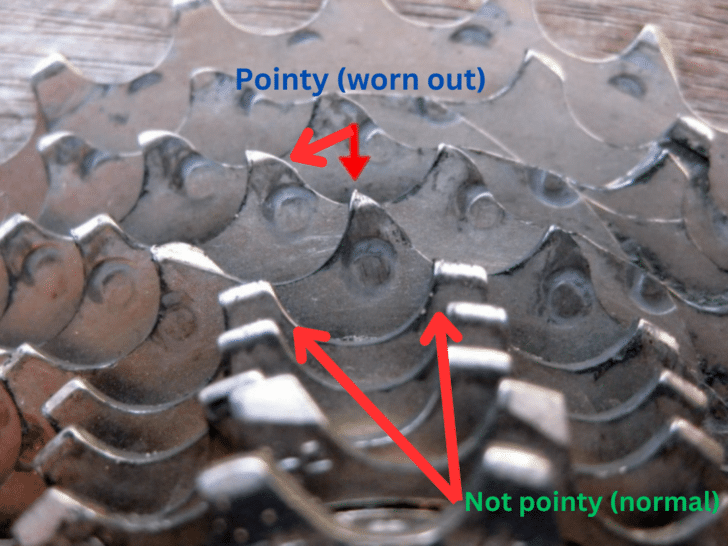
Solution: If your bike’s cassette is worn out, then you unfortunately will need to change it. Luckily, they last a long time; as an average cyclist would likely only need to replace their cassette once every few years.
4. Bent Rear Derailleur Hanger
The derailleur hanger is designed to keep the rear derailleur aligned with the cassette, and break or bend (instead of your bike frame) during impact. But why is that the case? Well, since they are made of soft aluminum, it unfortunately doesn’t take much impact for them to bend (source). This can impact your bike’s ability to shift gears.
If you’re a mountain biker or often ride on uneven trails, then you may have experienced this.
Solution: If it’s really bent, then I suggest you get it replaced. They are relatively inexpensive so it’s also worth keeping spares with you in your bag (especially if you have a mountain bike) in case yours breaks while you’re on the trail.
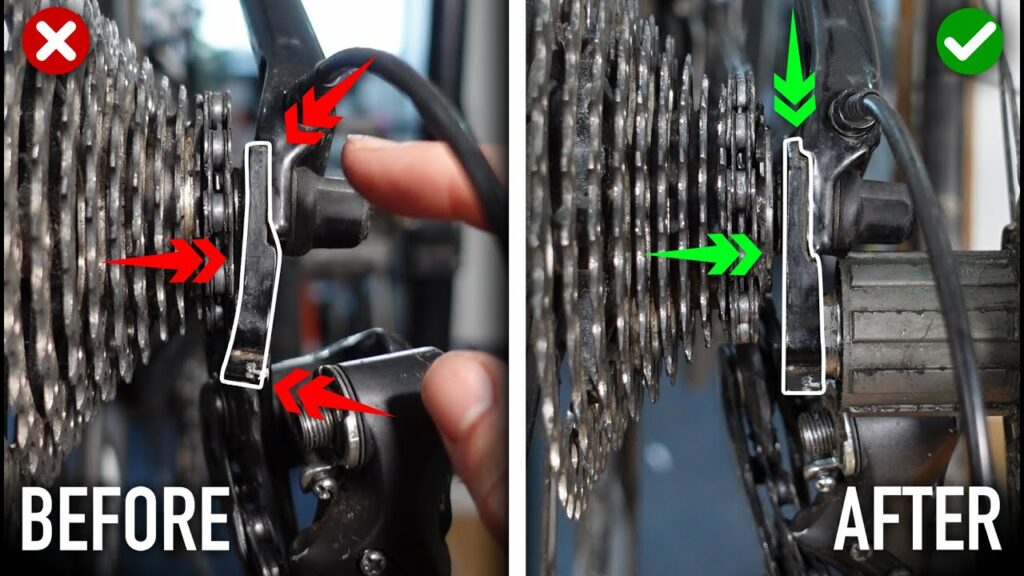
If it is slightly bent, then your best option is to use a derailleur hanger alignment gauge tool such as the Park DAG 2.2 Tool. You can find it on Amazon here.
If your derailleur hanger is not too bent, you don’t have the correct tool to amend it, and you are daring enough to try to fix it yourself 😎 then here’s a fantastic video for you to refer to. If not, then I recommend you take it to a bike shop to be adjusted.
5. The Rear Derailleur Is Out of Adjustment
If your rear or front derailleur is out of adjustment, this can cause your bike to have difficulties shifting to a higher or lower gear. If your chain is not shifting to a higher or lower cog on the cassette, then your derailleur may need adjustment. This can be due to the cable in the housing being stretched out over time, and as such needs to be tightened.
Solution:
- Put the bike on a repair stand, so you can spin the wheels freely by turning the pedal with your hand forward.
- If your chain is not going to the larger cog of the cassette when you spin, turn a barrel adjuster anti-clockwise. If it’s not going to the smaller cog, turn it clockwise to give the cable some slack. Do ensure to only turn it a quarter turn at a time (checking in between turns) until the bike is shifting properly.
And if you don’t know what the barrel adjusters are, here are the ones on my folding bike, to help you find yours:
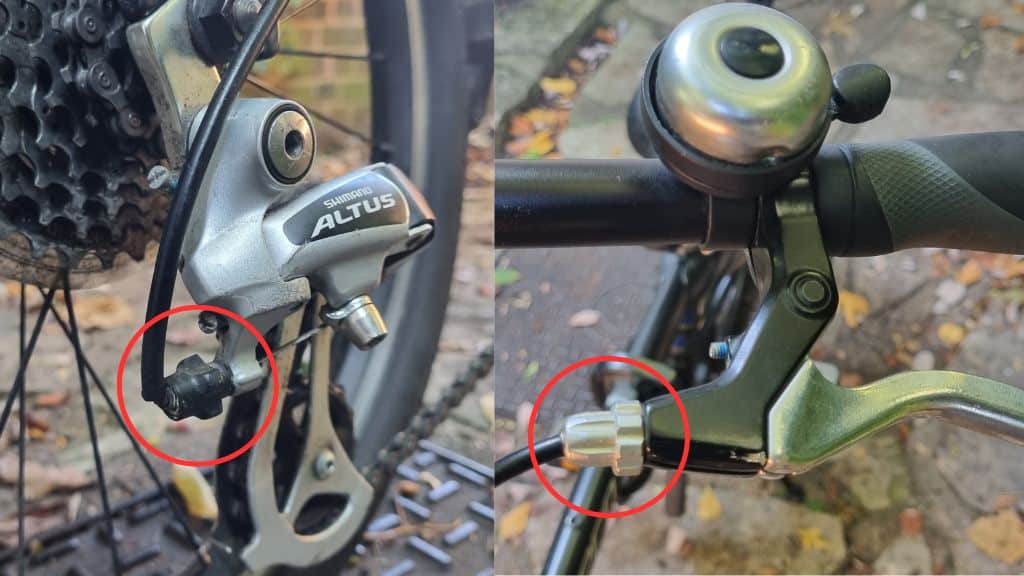
If your derailleur still keeps coming out of adjustment, then the bolt that holds the cable in place may also need to be tightened. Check if it’s tight enough. If it isn’t, then you may have difficulties shifting to the higher cogs. Slightly turn the bolt clockwise using an Allen or Torx wrench until it’s snug; ensuring to not overtighten it.

If none of these steps work for you, then I suggest you take your bike to the bike shop for repair.
6. Clogged Up Gunk Inside The Derallieur
Last year one of my bike buddies’ bike was not shifting properly. He took it to the bike shop and was told, “well why are you surprised it’s not working, you told me you never clean it!”. Although he did not appreciate the mechanic’s candor, it did encourage him (and myself after I stopped laughing a few times) to clean his bike often.
Riding often in wet conditions (as we did) can lead to all kinds of gunk being caught up in your bike. For his, it was the derailleur that had been filled up with it, and unfortunately unable to function properly. The gunked-up derailleur limited how far the derailleur could move.
Solution: To clean your derailleur, scrub it down with some WD40 or degreaser. You can then use a compressed air can to get as much of the WD40 out if you have one. If not then use a towel to pat it down as much as you can.
Then apply a lubricant such as Tri-Flow or synthetic oil (particularly on the pivot points) to help it work smoothly and protect it for longer from rust and corrosion.
7. Crack in Cable
Another cause of poor shifting can be a crack in the cable. This can be a result of the cable being bent at a sharp angle as it enters the derailleur. This can lead to the cable coming out of its housing, and cracking.
You can see a demonstration of it below on a second-hand folding bike I recently bought. As you can see, it has come out of the housing due to the sharp angle. It’s not yet developed a crack but it could over time due to the sharp angle. So I’ll keep an eye out on this and get a spare just in case I need to replace it.

Solution: Amend the route of the cable so it’s no longer at a sharp angle. If you have a folding bike, look at the position of the cable as you fold the bike. That’s because as the two wheels come together when you fold the bike, the cable could be bent around the folding mechanism. It then pulls itself into a sharp angle as it enters the barrel adjuster of the rear derailleur (as shown in the image above).
If your cable has cracks due to a sharp angle, replace it first as it could be the cause of your bike not shifting properly.
8. Limit Screws On Derailleur Need Adjustment
Limit screws set the range of travel for your rear derailleur. They determine how far your rear derailleur moves beneath the cassette cogs (source). There are B, H, and L limit screws. You can refer to the image below to see visually what they are and find them on your derailleur.
If your limit screws are not properly adjusted, it could lead to your bike not shifting to the biggest or smallest cogs on the cassette.
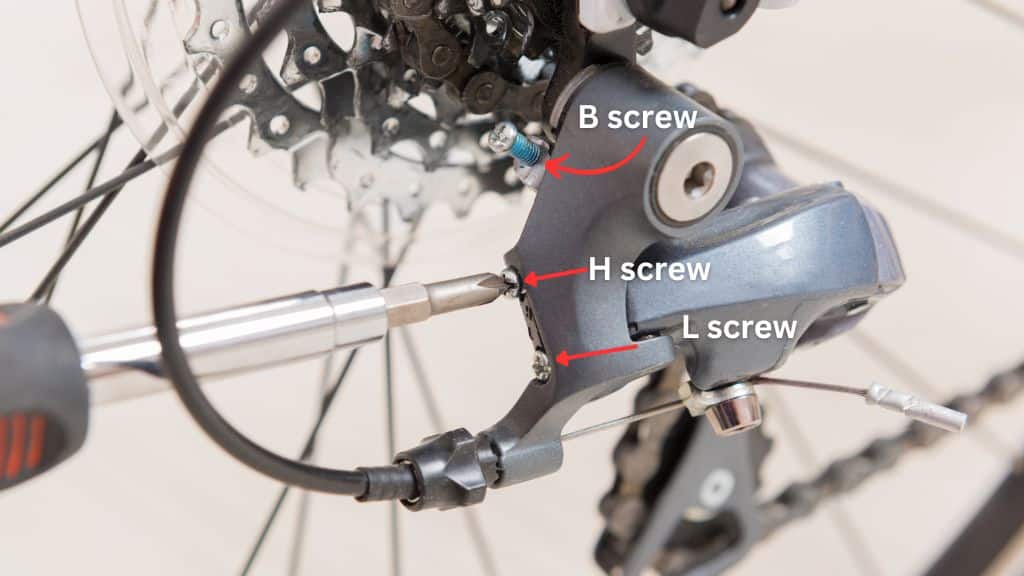
Solution:
- Put the bike on a repair stand, so you can spin the wheels freely by turning the pedal with your hand forward.
- Refer to the video below, which is a fantastic resource for adjusting your limit screws and ensuring the index setting of your rear derailleur is perfect. If this does not work for you (or is tricky to fix yourself) then your best bet is to take it to a bike mechanic.
9. The Shifter Doesn’t Click or Work
A shifter controls the gear mechanisms of the bike and allows you to select the desired gear ratio (source). If your shifter is not able to hold, pull, or release the cable linked to it as you operate the shifter, then there is likely a problem with it. You can test this by feeling the cable as you move the shifter. If you don’t hear a click as you move the shifter, it could also be a sign that it’s not working properly.
A common cause of a shifter not working is being filled up with gunk or clogged up grease inside.
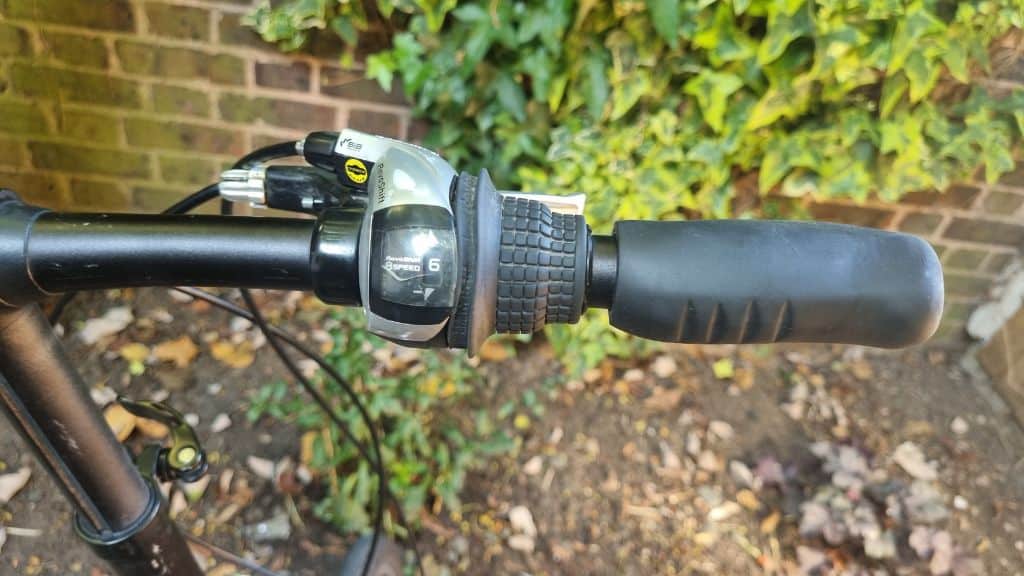
Solution:
- Take the shifter out of its casing, open it, and use WD40 to loosen it up or break down the old grease clogging it up. You can then use a compressed air can to get as much of the WD40 out if you have one. If not then use a towel to pat it down as much as you can.
- Then, use a lube (i.e. Tri-Flow) to lubricate the mechanisms inside so they can work and shift smoothly (2:00).
- Test the shifter to ensure it’s clicking. If so, put it back into its casing and refit it onto the bike. You can put some alcohol into the casing to help fit the shifter into it.
If this process doesn’t fix your shifter, then I recommend that you get a new one or take it to the bike shop for repair.
Here is an infographic with all the 9 reasons your bike may not be shifting, to share with your cycling friends who may need it most.

Conclusion
Your bike works as a unit of interconnected parts, working together to function as a whole. If one part is not working, it could impact your whole bike’s ability to work properly. Accordingly, your bike not shifting could be a result of an issue with the shifter, cable, cassette, chain or derailleur.
As shown in the article, you can fix a number of the shifting issues yourself; although it may be worth taking it to a bike mechanic if you find it a bit tricky to do so.
A number of the issues are due to a lack of maintenance or cleaning of your bike for an extended period of time. As such, it is normally a good idea to maintain and clean your bike whenever you can.
Before picking up your bike to ride next, ensure it is safe to do so by resolving any shifting issues that may be present.
Happy pedaling.
